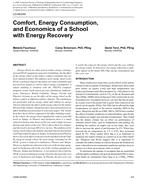
LO-09-049 — Comfort, Energy Consumption, and Economics of a School with Energy Recovery
- Comments Off on LO-09-049 — Comfort, Energy Consumption, and Economics of a School with Energy Recovery
- ASHRAE
Energy wheels are often used to reduce energy consumption and HVAC equipment capacities in buildings, but the effect of the energy wheel on the indoor comfort conditions has not been studied in detail. The addition of an energy wheel to the HVAC system may improve the indoor air relative humidity and perceived air quality as well as reduce energy consumption. A school building is modeled with the TRNSYS computer program, in four North American cities (Saskatoon, Saskatchewan; Vancouver, British Columbia; Tampa, Florida and Phoenix, Arizona) to see the effect of the energy wheel on the indoor comfort in different outdoor climates. The simulations are performed with an energy wheel and without an energy wheel to determine the effects of the energy wheel on the indoor RH and PAQ. Similar simulations have been performed on an office building and presented in a previous paper. The results from the school will be compared to the office building results. In the school, the energy wheel significantly reduces peak RH levels in Tampa. In Phoenix and Saskatoon there is a small reduction during some hours of the year and a slight increase during some hours of the year. This is due to their dry climates and the need to increase RH if it is too low. The addition of the energy wheel reduces the number of people that are dissatisfied with PAQ within the space in Tampa. In Saskatoon and Phoenix there is less of an effect on the percent dissatisfied with the PAQ. By using an energy wheel, the total energy consumed by the HVAC system is reduced in Saskatoon, Phoenix and Tampa. There is a significant reduction in the size of the heating equipment in Saskatoon and in the size of the cooling equipment in Phoenix, Tampa and Saskatoon. A cost analysis shows that the HVAC system including an energy wheel has the least life cycle costs in Saskatoon and Tampa. In Phoenix the life cycle cost is nearly the same for the energy wheel and the case without the energy wheel. In Vancouver, the energy wheel has a nefligible impact on the indoor RH, PAQ, energy consumption and life cycle cost.
Units: Dual
Citation: ASHRAE Transactions, vol. 115, pt. 2, Louisville 2009
Product Details
- Published:
- 2009
- Number of Pages:
- 12
- File Size:
- 1 file , 980 KB
- Product Code(s):
- D-LO-09-049

